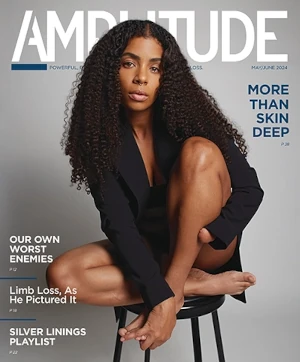My “baby arm” has always had his own name and his own personality. But I never dreamed he would become an ambassador for limb difference.
by Alexis Hillyard
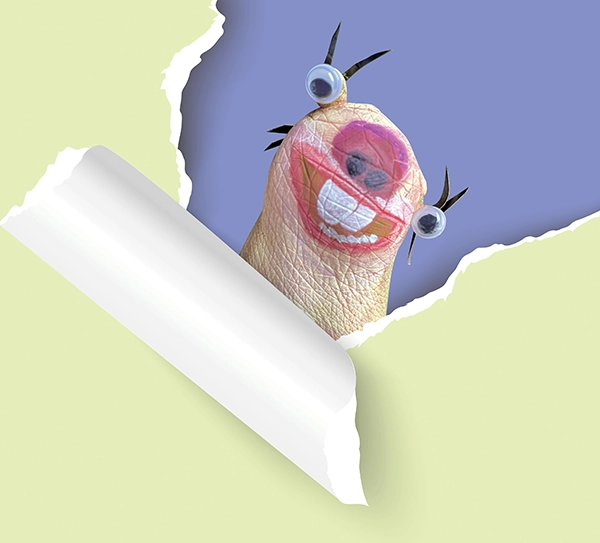
As children, my sister and I loved dessert (and we still do to this day). Being the older sibling, I crafted an ingenious way to get Ainsley to willingly—excitedly, even—give me some of her dessert. How did I do it? I told her that my stump, Bebe, was hungry and needed some dessert, too. And because Bebe didn’t have a mouth, the only way I could get the dessert to him was by eating it myself and passing it to him through my body.
Ainsley would gleefully oblige and hand me spoonfuls of her ice cream or cake. “Make sure it goes to Bebe!” she would shout, and I would answer, “Oh yes, of course!” As I swallowed, I would follow the food with my finger, drawing a line down my esophagus from my chin to my stomach, then up past my shoulder and down the end of my arm. I’d have Bebe do a full-body wiggle when the yummy treat arrived at its destination, and this would make my sister giggle with delight. It was a win all around.
This is how my stump got his personality and identity. Ainsley even named my arm—she was trying to say “baby hand,” it came out as “Bebe,” and the name stuck. Bebe evolved into a kind, loving, playful, and mischievous character who liked to play jokes, catch bad guys, and most of all make my sister smile. Bebe would also come out at school and at my choir rehearsals to entertain my friends and help them get to know me better. It helped me get to know myself better, too, and to cultivate an identity in which having a limb difference was ok.
Bebe has stuck with me my whole life. To this day, my sister, friends, and family interact with and love Bebe dearly. When I started gaining an audience on my YouTube channel, “Stump Kitchen,” the majority of my followers there (and later, on Instagram and TikTok) came to know Bebe, too, and it delights me to my core. Why? Because they, like my sister, see Bebe as someone. And someones tend to matter. Someones are folks you can interact with, fall in love with, and care for.
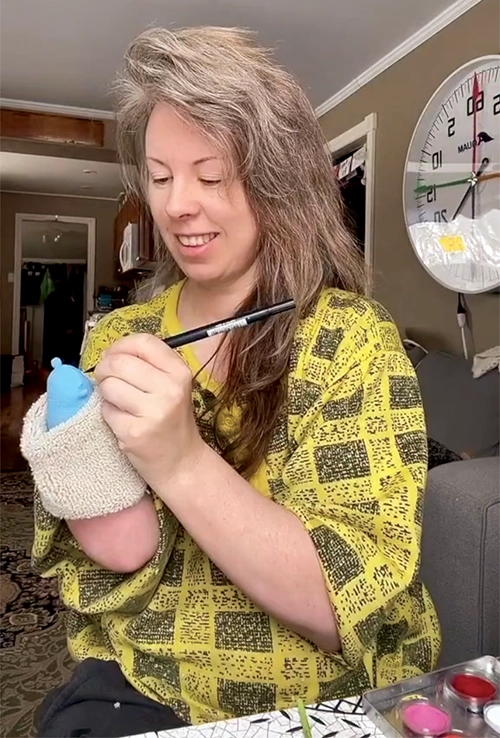
Someones are people you might even make an outfit for, which is what a viewer did for Bebe early last year. She sent me four different hand-crafted dresses, and I had a blast making a video of Bebe wearing them. Viewers seemed to like it, too, because they began sending requests to see Bebe in other costumes. First he dressed up as a snail. Then someone asked to see him as Stewie Griffin (from Family Guy). I didn’t consider myself an artist at the time, but I must have sold myself short. The Stewie Griffin cosplay video lit up the internet and ended up receiving over 5 million views in a week.
I was gobsmacked.
People immediately asked to see Bebe dressed up as all sorts of other characters. I made videos featuring my stump as Baby Shrek, Sid the Sloth (of Ice Age fame), and an axolotl. Viewers loved all three segments, and the ideas for additional characters started flooding in. Before I knew it, Bebe was a social media star in his own right, the king of limb-difference cosplay.
The overwhelming, joyful response to these videos took me completely by surprise. The most amazing part of it was that I started hearing from people who shared that they, too, have created unique identities for their limbs—including some who painted characters onto their stumps.
The outpouring of stories and connections got me wondering how many other amputees out there have their own “little someones.” I also started asking myself: Why do we do it?
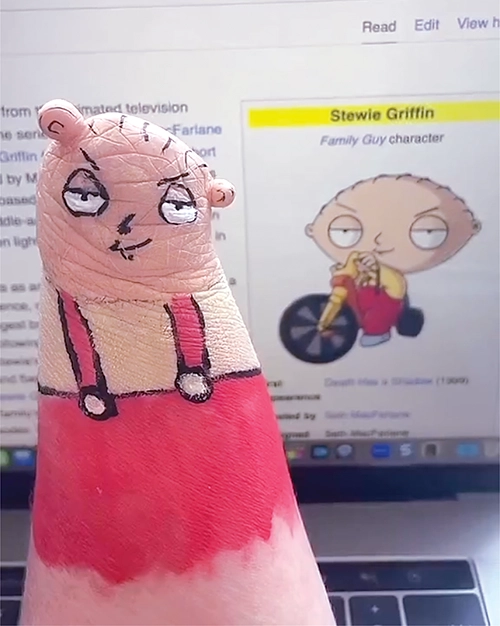
THE FIRST TIME I MET SOMEONE ELSE who personified her limb was about six years ago, when a woman named Sawyer reached out about doing an in-person cooking class with me. She had a limb difference similar to mine, so I jumped at the chance, because working with folks who have limb differences is my one true passion.
When Sawyer and I met, it was like a reunion of two old friends. After giving me a big hug, the first thing she did was introduce me to her arm, Rosie-Jo-Jo. I proudly introduced Bebe, and our two little arms shared greetings, which left Sawyer and I in stitches. We realized there weren’t just two people meeting; there were four of us.
Words can’t fully explain what it felt like to meet someone who related to their limb difference the same way I did. I felt very seen, safe, and at home. Personifying my limb has always helped me understand myself and embrace my limb difference.
This was particularly important during childhood, because I grew up in an era when disability was almost invisible. Social media didn’t exist, and mainstream media representations were rare and almost always negative. Bebe was my way of preemptively avoiding other people’s awkwardness and discomfort over my arm and sparing myself the exhaustion of managing their reactions.
“I think the personification actually brings awareness to our differences in a good way,” says Susan Powers, an upper-limb amputee who calls her stump Pedro. “It puts people at ease. It’s as if by drawing attention to the difference, that difference goes away. They are able to see past the physical and see the real me.”
The “real Susan” is an upbeat person who gets up before seven every morning, hates sleeping late, and loves the stillness before everyone else gets up. Powers is active in her church, adores singing and decorating, and loves to make people laugh. “There is always a silver lining,” she says. “Sometimes you just have to look harder to find it.”
And sometimes Pedro makes those silver linings easier to see. “Pedro is a big goof like I am,” says Powers. “I guess he is the extrovert I’d like to be, because I’m painfully shy at first. Personifying my limb difference makes me feel like a kid, and I love it.”
“I don’t even remember giving my arm a name or personality,” says Angel Giuffria, whose limb came to be known as Lil Arm at some point in early childhood. “That was just something that somehow was always there. My parents don’t remember doing it, and neither do I, but somehow my little arm became ‘Little Armie.’ It always felt like a choice I made, even if I don’t remember it.”
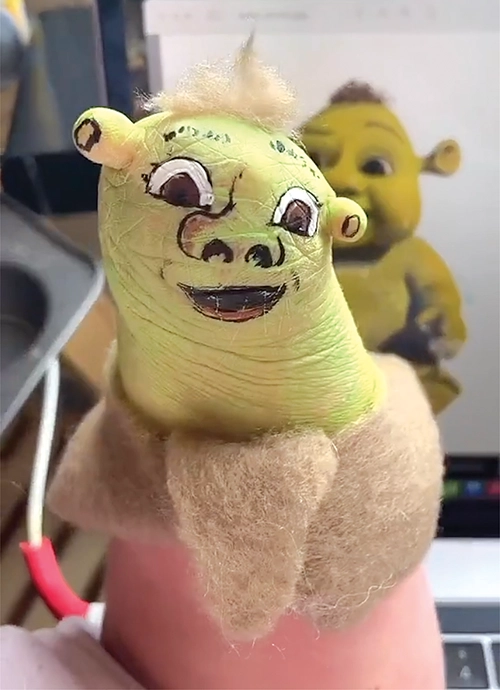
I met Giuffria through our work as ambassadors for the Lucky Fin Project, a Michigan-based organization that supports people with limb differences—especially kids and families. We clicked immediately. Giuffria is an actor and disability activist with boundless compassion and an infectious, bubbly spirit that pulled me in right away. Lil Arm has his own, totally distinct temperament that is equally appealing.
“I’m the nice, polite, on-my-best behavior one,” Giuffria says, “and he’s ready to stand up for me if needed. It sounds strange putting that down in writing, but I think of him as confident! Armie changed the framing of my limb difference from something sad, or something that people needed to be worried about, into something where I had more control over the narrative, so people didn’t pity me. It just really normalized the idea of having a limb difference for me.”
FOR MOST OF MY CHILDHOOD, Bebe’s face consisted of two eyes and a big smile that I drew with a blue ballpoint pen, with my thumb nubbin as a nose. Over time, my sister and I started adding little jackets, hats, and scarves to Bebe’s wardrobe, but it was always pretty basic. Yet those experiments seem to have planted the seeds of making art on a 3-D canvas. Because when, many years later, I started getting cosplay requests from my YouTube audience, I found it surprisingly easy to create complex, intricate characters on my arm, complete with hats, sweaters, beards, swords, and all sorts of other odd props.
After the Stewie Griffin video unexpectedly went viral in February 2023, the immediate requests for a follow-up video focused on two characters: Sid the Sloth and Shrek. I decided to start with Baby Shrek because of the cuteness overload. First, though, I needed to stock up on supplies, so I paid a visit to my local art shop and asked: “What do you sell that would be safe to paint on my arm?” I left with about 12 water-based watercolor crayons, some basic water-based facepaints, and a bit of modeling clay. I augmented those materials with whatever else a given character required. To make Baby Shrek’s hair, for example, I used some raw wool that my partner had bought for one of her art projects. For Sid the Sloth, I made eyelashes from thinly cut black construction paper and glued two googly eyes onto my tiny thumb and pinky.
Another early cosplay that I am deeply proud of is the axolotl, an endangered amphibian with a cherubic appearance. I hand-carved six fins out of pink clay, glued them onto my arm to frame the axolotl’s head, then used a textured painting technique where I layered different colors to add depth and volume to the face. The result was super cute, and my audience ate it up.
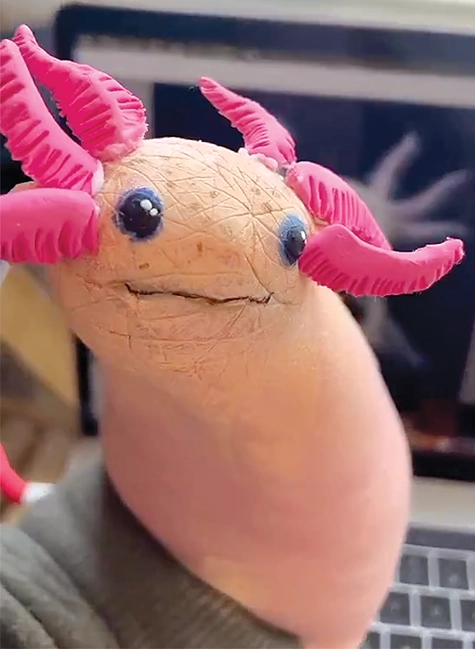
It was amazing how these little touches helped the characters spring to life—and they actually looked like the real thing! My audience really enjoyed these early cosplays, and more suggestions started rolling in. By midyear, the cosplay series had become a part of my regular routine: Each day I would look at the list, pick a new character, and surprise my followers (and sometimes myself) by bringing that figure to life.
I quickly learned that many people were emotionally invested in certain characters. They’d tell me a particular figure really resonated with them, for whatever reason—perhaps nostalgia for their childhood, an old friendship, or some other meaningful part of their life. I could sense the deep impact and feel their happiness at seeing Bebe transformed into their favorite, and it felt incredibly good to trigger these beautiful memories for my viewers.
One instance really stands out for me. I heard from a person named Alli who had recently had her hand amputated after sustaining a serious injury. She found my YouTube channel while searching for information about adapting to limb loss, and the cosplay videos helped Alli gain a new perspective. Because of the series, she told me, she planned to honor her stump with a name, and she couldn’t wait to start painting faces on her arm as soon as it was sufficiently healed.
Like most new amputees, Alli experienced many ups and downs of emotion, so I decided to dedicate a cosplay video to her featuring the character Sadness from the movie Inside Out. I didn’t identify Alli by name, but I did tell my viewers that I’d created this special episode to support someone who was navigating the turbulent transition to life with limb difference. That brought a huge outpouring of love and encouragement from the community. I worked extra hard on the painting, costume, and hair work, and it came out incredibly well; the likeness to the actual character was astounding. Alli and I have stayed in contact ever since.
THESE TYPES OF CONNECTIONS ARE a deeply rewarding aspect of Bebe’s cosplay adventures. I got to experience some of them in person last summer, when I went to Michigan for the Lucky Fin Project’s annual weekend get-together. This event brings hundreds of families together from all around North America to tell stories, have some laughs, and share the incredible feeling of being seen and accepted for exactly who we are. The event centers on children, and in my role as an ambassador, I always prepare an activity to do with the kids. One year I did cooking; another year I focused on making necklaces. This year’s activity was a no-brainer: stump-painting.
Many of the attendees must have been familiar with the cosplay videos, because as I was setting up my painting station, children were already lining up beside me, each one eagerly waiting to have their limb turned into Yoda, Elmo, Pikachu, or some other cherished persona. For the first kiddo, I used green, white, and gold paint to create a smiley, toothy alligator that fit his arm perfectly. Next I painted a rainbow with a pot of gold on a child’s hand that was ideally shaped for this image. She beamed when I told her that her body was beautifully made for this special scene, and it wouldn’t look quite the same on anybody else.
I was there for hours, meeting kids with all kinds of limbs and an equally varied set of cosplay requests. The line seemed endless, yet the time went by quickly, as we were all in our own little world of art, beauty, and celebration. I used my creativity and newly found expertise to size up each arm’s unique features and turn them into noses, teeth, hearts, and pots of gold, so that every creation fit the limb and the child to perfection. I can barely describe the feeling it gave me to see their little faces light up with pride at the sight of their personalized body art.
The Lucky Fin booth felt like a flashback to my childhood, when Bebe and I used to perform little skits and do some rudimentary cosplay to make my baby sister smile. It was such a soft and gentle way for me to develop compassion and love for my disabled body, and it has influenced my relationship to my limb difference ever since. I’d like to think that by sharing Bebe with the world on social media, and humanizing him through cosplay, I’ve enabled my online audience to see disability through fresh eyes and engage with it on a new, more authentic level.
And isn’t that the purpose of art—to transcend barriers and convey intricate human emotion that is hard to put into words? If that’s the case, I hope my cosplay videos invite people, both disabled and nondisabled, to relate to me and other amputees with greater emotional clarity. I also hope the videos portray limb difference as a normal dimension of human experience and raise awareness in a delicate way, using watercolor, clay, and whimsy to alter perceptions and promote understanding. Maybe by “disarming” audiences through costumes and disguises, Bebe and I can help people recognize what an authentic amputee identity really looks like.
Alexis Hillyard is creator of the award-winning “Stump Kitchen” channel on YouTube. Find her online at stumpkitchen.com.
Turn Your Limb Into Anyone: A Step-By-Step Guide
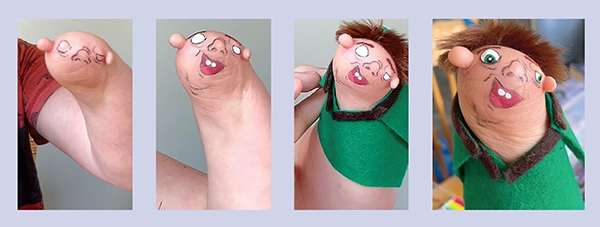
Step 1: Use high-quality, hypoallergenic face paint and fine-tipped paint brushes. I love Fusion Body Art and Diamond FX.
Step 2: Use multiple media like fabrics, buttons, faux fur, and other materials to create depth and texture. Elmer’s glue works great and washes off with soap and water.
Step 3: Use a fine-tip brush to create a light outline of your character on your body, then allow it to dry.
Step 4: Apply base colors to your character’s face and body, then allow them to dry.
Step 5: Add clothing, hair, props, and other elements.
Step 6: Fill in the final details and highlights to your character’s face to really bring them to life.
Photos courtesy Alexis Hillyard.



